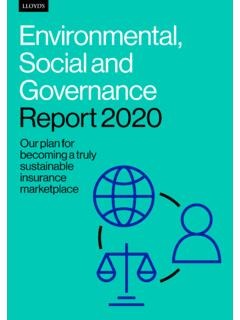Transcription of LLOYD’S Risk codes
1 Classification: Confidential LLOYD S Risk codes Guidance and mappings july 2021 Classification: Confidential Disclaimer The guidance notes relate to Lloyd's risk coding system and provide background information, general principles which apply to all codes , and detailed guidance on certain specific risk codes . These guidance notes are provided in order to assist Lloyd's underwriters with the correct selection of risk codes , and to assist Lloyd's brokers and Lloyd's managing agents in matters relating to the processing and reporting of insurance business written at Lloyd's. Whilst these guidance notes may also be read by any person(s) seeking general information, Lloyd's accepts no liability arising as a result of such person(s) placing reliance on the information contained therein.
2 Classification: Confidential Contents 1 Purpose 1 2 Principles of the Scheme 1 3 Operation of the Scheme in General 2 Responsibility for Coding Risks 2 Selection of codes 2 Reinsurance 3 Multiple Risks 4 USA/ Non-USA Designated Risk codes 4 Binding Authorities, Covers and Service Companies 5 Coding of Claims 5 4 Guidance for Specific Risk codes / Classes of Business 6 Accident & Health 6 Aviation 6 Casualty 6 Energy 8 Engineering 8 Marine 9 Nuclear 9 Nuclear, Chemical, Biological and Radiological 9 Pecuniary 9 Political Risk and Financial Guarantee 10 Renewable Energy and Power Generation 11 Property 12 Term Life 16 Terrorism 16 Third Party Reinsurance to Close (RITC) 18 1 Classification: Confidential 1 Purpose The purpose of this document is to give guidance to underwriters and Lloyd s brokers on the classification of business into various categories using the Lloyd s risk coding scheme.
3 This document discusses underlying principles of the scheme, matters which apply to its operation in general, and matters which apply to specific classes of business/risk codes . 2 Principles of the SchemeThe risk codes scheme provides a common basis for the classification/description of risks so that: All underwriters on a particular risk use the same description and So far as is practical, risks are described consistently. The scheme takes account of, and is a balance between, three main but differing requirements: Underwriting practice - to accommodate the various bases on which business is written. Statutory reporting - which has regard to the underlying insurance risk irrespective of how the business is placed. Various Lloyd s requirements for the monitoring of performance and reporting of business to various interested parties including domestic and overseas regulators, capital providers and rating agencies.
4 The risk coding scheme is not intended as, nor can it be, a substitute for the proper analysis and description of risks according to managing agents' own systems, but rather is to provide a common minimum level of detail which can be supplemented by managing agents own risk recording systems according to the special circumstances of each syndicate. Lloyd s may, from time to time, set up new risk codes where there is a sound business case for doing so and in these instances the Lloyd s Market Association (LMA) will be consulted. In addition, underwriters may request new codes . In these circumstances requests must always be made via the LMA and on receiving the Association s support, the LMA will then make an approach to Lloyd s Performance Management directorate (PMD). Performance Management - Supplemental Requirements and Guidance is intended to assist the market by providing a single point of reference for Lloyd s supplemental performance management requirements on a range of subjects.
5 The document is updated on a regular basis to ensure that the requirements and guidance remain current and relevant. Please refer to these for these for further guidance. 2 Classification: Confidential 3 Operation of the Scheme in General Responsibility for Coding Risks It is the responsibility of the leading Lloyd's underwriter on the risk to classify the risk with the appropriate risk code(s). Where a multi-peril policy comprises different sections which are insured separately by different syndicates, the underwriter of the leading syndicate of each section must classify the business for the syndicates in that section. However, it is also the responsibility of all following underwriters to ensure that the correct code(s) has been allocated. codes applied by the leading Lloyd's underwriter should not be altered or added to without the leading Lloyd's underwriter's approval.
6 Should a following underwriter wish to amend a risk code, he should refer the matter directly to the leading Lloyd's underwriter. Should there be any doubt as to the correct code or codes to be used, the matter should be referred in the first instance to XIS s Enquire Helpline on 0870 380 0830 (option 2) for assistance. The Class of Business section of Lloyd s PMD or the LMA should also be able to provide guidance. As has historically been the case, and will continue to be so, the risk code(s) selected by the leading Lloyd s underwriter of a policy or section of a policy must also be used by all following Lloyd's underwriters on that policy or section. XIS has been instructed to reject policies which are processed by them and which have non-uniform risk-coding back to the broker with the instruction that the leading Lloyd s underwriter and the following market discuss the matter further until agreement is reached.
7 In the case of policies not processed by XIS it is the responsibility of following Lloyd s syndicates to ensure that they apply the same risk code as the Lloyd s leader and, if applicable, obtain the leader s agreement to any variation of that risk code. Selection of codes Some risk codes are very specific, for example HP applicable to UK household insurance, and some broadly generic, for example T applicable to most risks in respect of maritime vessels. All insurance and reinsurances should be coded under the category of business which is most specific and which most appropriately reflects the business being underwritten. If there is no specific classification, the leading underwriter should use best judgement to select the most appropriate code(s). Risk codes may be specific as to territory, policy form (for example claims made or occurrence) or other criteria.
8 Guidance on applying such criteria is contained in section 4. Should the contract include other classes of business and/ or cover for more than one territory (where these characteristics are to be distinguished by separate risk codes ), underwriters should refer to Multiple risks for further guidance (see section ). Premium relating to business for which specific premium income limits and/or monitoring requirements apply must be split out and allocated to the appropriate risk code, including where written as part of general inwards excess of loss and whole account coverage. The risk codes in question are CF, CR, FG, FM, SB (please refer to section ), CY, CZ (please refer to section ) and WL. A number of risk codes differentiate between "including USA" and "excluding USA".
9 Underwriters should refer to USA/ non-USA designated risk codes for further guidance (see section ). 3 Classification: Confidential In order to assist underwriters, a table is provided to this guidance labelled Risk Code Mappings and Full Descriptions which lists the risk codes with full extended definitions. Reinsurance Inwards Reinsurance Facultative reinsurance All facultative reinsurance risks, whether first loss, proportional or excess of loss, should be coded using the same risk code(s) that would apply if the risk were direct. Proportional reinsurance treaties There are a number of proportional reinsurance treaty codes available for different risk types and underwriters should use the most appropriate ( TR ( Property Proportional ), HA, CC). Where there is no class specific proportional treaty code, the most appropriate direct risk code should be used Non-proportional reinsurance treaties All non-proportional treaties applicable to specific classes of business should be coded with the most appropriate specific inwards excess of loss code listed and should NOT be allocated to one of the specific direct codes .
10 Where there is no specific code listed for the business being protected, underwriters should use the most appropriate non-proportional treaty code. For example, a direct or facultative professional indemnity (re)insurance would carry one of the E2-E9 codes ( Professional Indemnity E& ) but one of codes XF, XG and XH ( NM Liability Excess of ) should be selected when protecting an insurer s specific book of professional indemnity business on an excess of loss treaty basis. Underwriters should note that the term excess loss treaty should apply to all types of non-proportional treaties ( including aggregate excess and stop loss). Where the reinsurance protects all the writings of an insurer or reinsurer, the appropriate whole account excess of loss (or whole account excess of loss on excess of loss) treaty reinsurance code should be selected, for example, XT ( Marine Whole Account XOL incl War ) or X2 ( Marine XOL on XOL incl War ).










